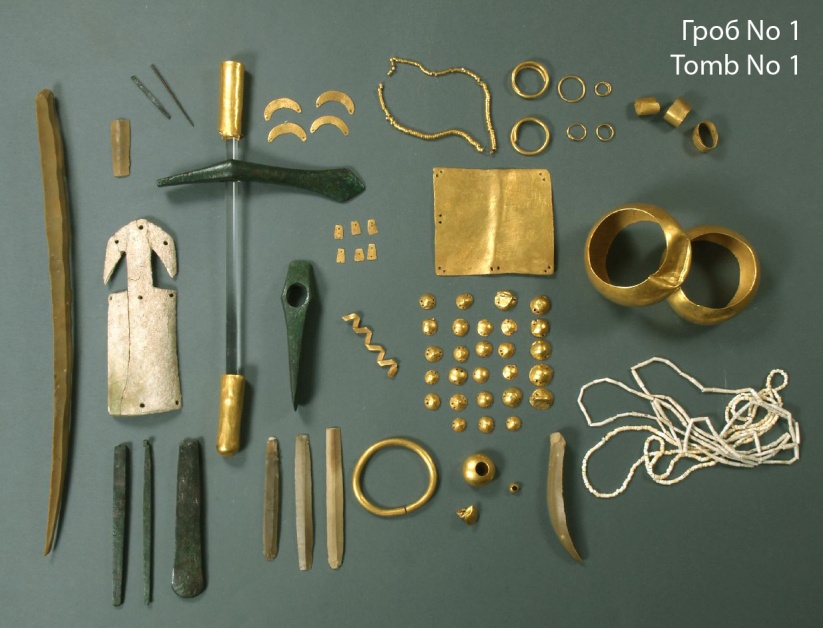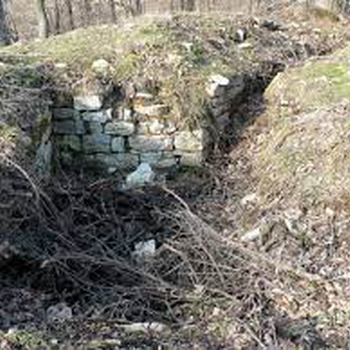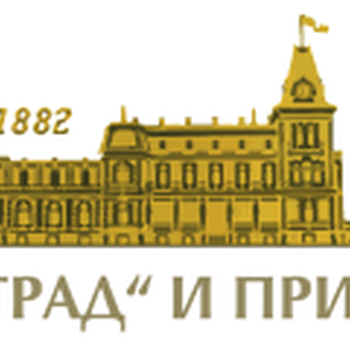Varna Chalcolithic necropolis
Overview
The Varna Chalcolithic necropolis was discovered in 1972 in the area of Varna Lake and is dated to the end of the 5th - beginning of the 4th millennium BC. It is believed that the finds of "Varna gold" is the oldest technologically processed gold in Europe and the world, belonging to the so-called Varna Culture (fifth millennium BC).
Tomb № 1 - symbolic burial Discovered during construction works in 1972. The burial pit is rectangular, discovered at a depth of 1.45 m. Oriented northeast - southwest. A strip of red ocher 1 cm thick was traced at the bottom of the pit and lumps of burnt clay (remains of an anthropomorphic figure?) Were found. Probably the objects were arranged as in a real man's funeral. The inventory consists of 7 copper utensils, 6 flint plates, a fragment of a marble vessel, a bone idol, two ceramic vessels, beads of kaolin and malachite and 1640 shells of the Mediterranean mollusk dentalium. 3 bracelets, a breastplate, fittings from a scepter handle, bow fittings, 170 beads and garment applications - 222 items, with a total weight of 1092 grams - are made of gold. Chalcolithic, 5th millennium BC AM Varna / NIM
Tomb № 2 - symbolic burial of an idol The burial pit is rectangular, measuring 2.25 x 0.90 m, at a depth of 1.50 m. Orientation - northeast - southwest. At the bottom of the pit is traced a layer of dark organic matter and red ocher - on top were found objects of gold, copper, flint, bone and clay. Above them is traced a layer of organic matter and red ocher. In the northeastern part of the pit was found a relief modeled human face in a face of slightly burnt clay measuring 20 x 19.5 cm. A gold tiara was placed on the forehead, 5 earrings were strung on the left ear and 3 on the right; the eyes are marked with gold round plates, the mouth - with a rectangular gold plate, and under it are driven 7 gold nails. On the neck - two golden anthropomorphic amulets. To the east of the clay face was found a group of four clay vessels and two gold rings. At the southwestern end of the pit were found a corrugated bone idol, a copper needle, a flint plate, a stone vertebra for a spindle, gold appliques for a garment and shells of dentalium. Chalcolithic, 5th millennium BC NIM / AM Varna A copy
Tomb № 3 - symbolic burial of an idol The burial pit is rectangular, measuring 1.95 x 1 m, at a depth of 1.60 m. Orientation - northeast - southwest. A layer of dark organic matter and red ocher was traced at the bottom of the pit and above the finds. In the northeastern part of the pit was found a relief modeled human face in a face of slightly burnt clay measuring 21 x 18 cm. The anatomical details - eyes, mouth and teeth are marked with gold plates; gold rings are strung on the ears, a gold tiara on the forehead and two strings of kaolin beads with one gold anthropomorphic amulet on the neck. Three ceramic vessels were discovered east of the face. In the southwestern part of the pit are placed a marble idol, gold appliques and nails, a flint plate, a marble vessel, a lump of graphite and 39 shells of dentalium. In the middle of the pit, 28 triangular bone applications were found, probably from a belt. Chalcolithic, 5th millennium BC
Recommended
- Dolphinarium, Varna
- Panoramic Galata site
- Aquarium, Varna
- Bridge of desires
- Archaeological Museum
- Sea Garden
- Lighthouse
- Doll Museum;
- Lake in the sea garden


 Bulgarian
Bulgarian Romanian
Romanian




